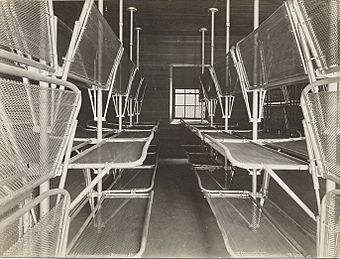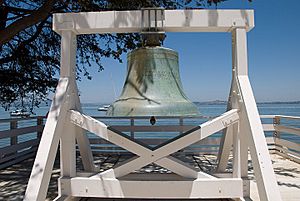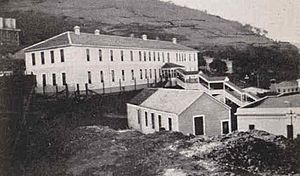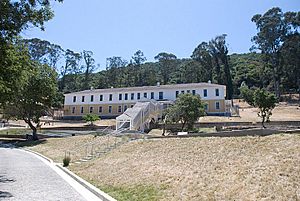Angel Island Immigration Station facts for kids
|
Angel Island
|
|

Angel Island Dormitory
|
|
| Nearest city | Tiburon, California |
|---|---|
| Area | 20 acres (8.1 ha) |
| Built | started 1905; opened 1910 |
| Architect | Walter J. Mathews |
| Architectural style | Mission/Spanish Revival |
| NRHP reference No. | 71000164 |
Quick facts for kids Significant dates |
|
| Added to NRHP | October 14, 1971 |
| Designated NHLD | December 9, 1997 |
The Angel Island Immigration Station was a special place in San Francisco Bay. From 1910 to 1940, it was where many immigrants coming to the United States had to stop. They were held there and asked many questions before they could enter the country. About 100,000 Chinese immigrants and tens of thousands of Japanese people, along with others, came through this station.
Angel Island is an island in San Francisco Bay. Today, it is a State Park managed by California State Parks. It is also a California Historical Landmark. Long ago, Native American tribes like the Coastal Miwok used the island for fishing and hunting. Later, it became a safe spot for Spanish explorers. It was also a cattle ranch and then a U.S. Army base during the Civil War.
During its time as an immigration station, the island held hundreds of thousands of immigrants. Most of them came from China, Japan, India, Mexico, and the Philippines. The station was built on an island to keep immigrants separate. This made it easier to control them and stop diseases from spreading. It also helped to enforce new immigration laws. After the station closed, it was left empty for a while. However, messages carved into the walls by immigrants helped save the buildings. The main building was fixed up, and a nearby hospital became a museum in 2022.
The station is now listed on the National Register of Historic Places. It is also a National Historic Landmark. You can visit the station today as a museum. It helps us remember the history of immigrants coming to America.
Contents
History of Angel Island
In 1850, the President of the United States said Angel Island would be a military area. During the Civil War, the island had forts to protect San Francisco Bay. Before Angel Island, new arrivals in San Francisco were processed at the city's docks. These places became too small and dirty. So, in 1904, a study suggested building a new immigration station. They chose Angel Island because it was isolated.
In 1905, the Army gave 20 acres of land on the island's north side for the new station. Architect Walter J. Mathews designed the station. It included a detention center with an outdoor area and a guard tower. There was also an administration building, a hospital, a power station, and a dock. This dock became known as China Cove.
Building the "Ellis Island of the West"
Construction of the Angel Island Immigration Station began in 1905. It opened on January 21, 1910. People sometimes called it the "Ellis Island of the West." Building the station involved clearing an old Coast Miwok village site. This included removing ancient shell mounds and buried remains.
The main difference between Ellis Island in New York and Angel Island was where most immigrants came from. At Angel Island, most immigrants were from Asian countries. These included China, Japan, and India. The station was built to control the number of Chinese immigrants. This was because of the Chinese Exclusion Act of 1882. This law only allowed certain Chinese people to enter. These included merchants, religious leaders, diplomats, teachers, and students. Laborers were not allowed.
At Ellis Island, only about 1 to 3 percent of immigrants were turned away. But at Angel Island, about 18 percent were rejected. Chinese immigrants were often targeted. This was because many Chinese people were arriving in the United States. Some Americans worried that Chinese immigrants took low-paying jobs. After an economic downturn in the 1870s, many Americans faced unemployment. This led to more unfair treatment against Chinese people. They were sometimes seen as unsuitable because of their appearance and social status. The detention center opened in 1910. This was after new laws greatly limited Chinese immigration. Immigrants came from 84 countries. Chinese immigrants were the largest group until 1915, when Japanese immigrants became more numerous.
Life at the Station: 1910–1940
The time immigrants spent at Angel Island varied a lot. Some stayed only a few days, while others stayed for months. The longest recorded stay was 22 months. This was very different from Ellis Island. There, rules were more relaxed, and many immigrants entered the U.S. on the day they arrived. Interrogations at Angel Island took longer because of unfair treatment against Asians.
Many Chinese immigrants, mostly men, claimed to be sons of Chinese American citizens. They did this because of the Chinese Exclusion Act. Children of U.S. citizens are also citizens, no matter where they are born. So, they could not be denied entry if they proved their family link. Immigrants who falsely claimed family ties were called "paper sons" or "paper daughters." Some Chinese American citizens helped with this by pretending to be parents. They did this for money or to help others of their background.
Because of this, a long and difficult questioning process was created. It was meant to find out who was lying. The person applying would go before a special board. This board had two immigration inspectors, a note-taker, and sometimes a translator. For hours or days, the person would be asked very specific questions. Only a real family member would know the answers. These questions were about their family history, their village, and their homes. However, some people prepared for these questions months ahead. They would memorize answers with help from their sponsors.
To make sure the person was telling the truth, witnesses from the U.S. were called. These were often other family members. These "family members" sometimes lived far away. This made the process even longer, as their stories had to be checked. If there was any doubt, the questioning continued. If their story did not match what the witnesses said, the applicant and their family could be sent back.
Some people appealed the board's decision. This meant they stayed even longer at the detention center. The appeal process was very long and tiring. Also, how long someone stayed depended on their home country. Japanese immigrants often had documents from their government. These documents helped them enter the country faster. Because of this, most people held at Angel Island were Chinese. They had no choice but to go through the long questioning. The goal at Angel Island was to deport as many Chinese immigrants as possible. So, the process was much harder for Chinese people than for others.
After 1940: A New Purpose
The Immigration Station worked for 30 years. But there were worries about cleanliness and safety for the immigrants. These worries proved true in 1940. A fire destroyed the administration building and the women's living area. Because of the fire, all 200 immigrants were moved to a facility in San Francisco. The former Immigration Station was given back to the U.S. Army. During World War II, it was used to process prisoners of war. In 1943, the U.S. government ended the Chinese Exclusion Act.
After the war, the Army closed its bases on the island. They left the old Immigration Station to fall apart. It was not until 1963 that the island became a state park. The buildings were planned to be torn down. But in 1970, a park ranger named Alexander Weiss found something amazing. He discovered Chinese poems carved into the wooden walls of the men's barracks. The poems were partly hidden by layers of paint. These poems became a memorial to all who passed through the station. They tell the story of their journey to a new life in the U.S.
Today, more than 200 poems have been found and restored. Most of the detention centers are now open to the public. About one million immigrants were processed at Angel Island. Roughly 175,000 were Chinese and 117,000 were Japanese. Between 75 and 82 percent of them successfully entered America.
Immigrant Stories and Poems
Many Chinese immigrants held at Angel Island did not feel welcome in the United States. One person detained in 1940 said, "When we arrived, they locked us up like criminals in compartments like the cages at the zoo." People were kept in these "cages" for weeks or months. They faced many long and stressful interrogations. These questions were meant to check if their immigration applications were real. Immigrants had to remember tiny details about their lives. Sometimes, the translators did not speak the exact Chinese dialect of the immigrant. Most Chinese immigrants at that time were from southern China and spoke Cantonese.
It was hard to pass the interrogations. Cases were appealed many times before someone could leave the island. Often, successful immigrants created detailed guides. These guides helped other detainees pass the interrogations. If anyone was caught with these guides, they would likely be sent back to China. Those who failed these tests often feared the shame of returning home. Some even took their own lives before leaving or on the way back.
Many detainees wrote poems to express their feelings. They carved their emotions onto the very walls that held them. Many of these poems were written with pencil, ink, or brush. Then they were carved into the wooden walls or floors. Some poems were sad and angry. Others were calm and thoughtful, or even full of hope.
America has power, but not justice.
In prison, we were victimized as if we were guilty.
Given no opportunity to explain, it was really brutal.
I bow my head in reflection but there is nothing I can do.
Another example:
I thoroughly hate the barbarians because they do not respect justice.
They continually promulgate harsh laws to show off their prowess.
They oppress the overseas Chinese and also violate treaties.
They examine for hookworms and practice hundreds of despotic acts.
A more hopeful example:
Twice I have passed through the blue ocean, experienced the wind and dust of journey.
Confinement in the wooden building has pained me doubly.
With a weak country, we must all join together in urgent effort.
It depends on all of us together to roll back the wild wave.
Angel Island Chinese Monument
The Angel Island Chinese Monument (37°52′13″N 122°25′32″W / 37.87023°N 122.42563°W) is a special monument. It honors Chinese immigrants who came to the United States through the immigration station. It was finished in 1978 and placed in 1979. The monument's message says: "Leaving their homes and villages, they crossed the ocean only to endure confinement in these barracks. Conquering frontiers and barriers, they pioneered a new life by the Golden Gate." This message reminds us of the Chinese poems carved into the barracks walls by the immigrants.
See also
- Paper Sons
- Tye Leung Schulze; the first Chinese American civil servant in the United States, who worked at Angel Island.
- Tyrus Wong, imprisoned on Angel Island when he was nine, he was later released and became the chief artist for Disney's Bambi.









